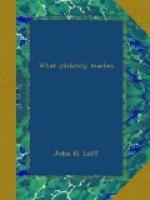In the case of postage stamps, where it is desired to exactly duplicate the design many times on a plate, recourse is had to transfer rolls. A transfer roll is a piece of soft steel, in shape a cross section of a cylinder. The edge is sufficiently wide to receive an impression from the die. We show you here a picture of a transfer press. From each side of the roll projects a small pin or trunion. These pins form an axle for the roll and by them it is held in the carrier of the press. A is the roll in the carrier. The die is placed on the table or bed B. The roll is held against the die with a pressure of many tons, obtained by compound leverage. By means of the wheel, E, and the connecting pinion and rack, the bed, carrying with it the die, is moved back and forth under the roll. This is called “rocking” and by it the soft steel of the roll is forced into the die and a reverse impression of the design is obtained. The roll is then hardened and, by a reversal of the process, impressions from it are transferred to the steel plate from which the stamps are to be printed. The plate is, of course, soft at first and is hardened after the required number of designs have been transferred to it. This process is so perfect that the most delicate lines of the die are repeated with absolute fidelity on the plate. When many plates of a stamp are likely to be needed, it is customary, in order to avoid risk of wear or damage to the original die, to make duplicate dies, called transfer dies, and from them the necessary rolls to make the plates.
The plates are made with great care. They are touched up by hand and subjected to close scrutiny and the work is often gone over a number of times before the result is pronounced satisfactory. Incidentally any guide lines and marks used by the transferrer are removed by burnishing. In the older issues of United States stamps, such lines and dots are frequently found on the stamps but the later issues are very free from them.
Plates that have become worn are “re-entered,” that is to say, the transfer roll is applied to the plate in the original position and the lines thus sharpened and deepened. If, by any mistake in making or re-entering a plate, the roll is incorrectly placed and then changed to the correct spot, a double impression of some of the stronger lines will result. This is called a “double transfer” and sometimes, though wrongly, a “shifted die.” These double transfers are quite common in the United States stamps made before 1861 but are scarce in the late issues, either because the work is now more carefully done or because any mistakes have been corrected. Such a correction is effected by turning the plate on its face on a hard substance, hammering on the back until the surface is driven up smooth and then entering the design anew.
A number of very delicate machines are used as aids to the engraver, though much more for bank-notes and large pieces of work than for postage stamps. These are called ruling machines, medallion rulers, cycloidal and geometric lathes. Ruling machines are used to make the backgrounds of portraits, the shadings of letters and similar work.




